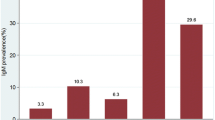Abstract
Rubella, commonly known as ‘German Measles’ is a common childhood viral disease that may affect adults as well. More than half of the infections are either asymptomatic or present with mild flu like illness with a typical maculopapular rash. In contrast, primary rubella infection in pregnancy, especially in the first trimester, can have serious consequences, namely miscarriage, intrauterine fetal demise or congenital rubella syndrome (CRS). WHO recognizes CRS as the ‘leading vaccine preventable cause of birth defects’. Antenatal management primarily is based on testing for immunity in the first trimester and recognizing acute maternal infection. A correct interpretation of maternal serology using IgG avidity along with IgM and IgG is imperative to avoid false positive diagnoses. Diagnosis of fetal infection is by detection of Rubella virus specific RTPCR in amniotic fluid and is indicated if maternal seroconversion is seen in the periconceptional period and/or the first trimester or if there are ultrasound features suggestive of fetal infection. Since there is no treatment available to either prevent mother to child transmission or to treat fetal infection, the mainstay is prevention. India is amongst the 11 countries of WHO South East Asia Region who are committed to control of Rubella and CRS by 2020.

Similar content being viewed by others
References
Miller E, Cradock-Watson JE, Pollock TM. Consequences of confirmed maternal rubella at successive stages of pregnancy. Lancet. 1982;2(8302):781–4.
Gregg NM. Congenital cataract following German measles in mother. Trans Ophthalmol Soc Aust. 1944;3:35–46.
World Health Organization India. India launches one of the world’s largest vaccination campaigns against measles and rubella syndrome with WHO support. New Delhi, India: World Health Organization Regional Office for South-East Asia; 2017. https://www.searo.who.int/india/mediacentre/events/2017/Measles_Rubella/en. Accessed 11 July 2017.
Murhekar M, Bavdekar A, Benakappa A, et al. Sentinel surveillance for congenital rubella syndrome—India, 2016–2017. MMWR Morb Mortal Wkly Rep. 2018;67(36):1012–6.
World Health Organization. Strategic plan for measles elimination and rubella and congenital rubella syndrome control in the South-East Asia Region. New Delhi, India: World Health Organization Regional Office for South-East Asia; 2015. https://www.searo.who.int/immunization/documents/sear_mr_strategic_plan_2014_2020.pdf
Bouthry E, Picone O, Hamdi G, et al. Rubella and pregnancy: diagnosis, management and outcomes. Prenat Diagn. 2014;34(13):1246–53.
Vauloup-Fellous C, Grangeot-Keros L. Humoral immune response after primary rubella virus infection and after vaccination. Clin Vaccine Immunol. 2007;14:644–7.
Deka D, Rustgi R, Singh S, et al. Diagnosis of acute rubella infection in pregnancy. J Obstet Gynecol India. 2006;56(1):44–6.
Best JM, O'Shea S, Tipples G, Davies N, Al-Khusaiby SM, Krause A, et al. Interpretation of rubella serology in pregnancy–pitfalls and problems. BMJ. 2002;325(7356):147–8.
Vauloup-Fellous C, Ursulet-Diser J, Grangeot-Keros L. Development of a rapid and convenient method for determination of rubella virus-specific immunoglobulin G avidity. Clin Vaccine Immunol. 2007;14:1416–9.
Macé M, Cointe D, Six C, et al. Diagnostic value of reverse transcription-PCR of amniotic fluid for prenatal diagnosis of congenital rubella infection in pregnant women with confirmed primary rubella infection. J Clin Microbiol. 2004;42:4818–20.
Yazigi A, De Pecoulas AE, Vauloup-Fellous C, et al. Fetal and neonatal abnormalities due to congenital rubella syndrome: a review of literature. J Matern Fetal Neonatal Med. 2017;30(3):274–8.
Lambert N, Strebel P, Orenstein W, et al. Rubella. Lancet. 2015;385(9984):2297–307.
Cordier AG, Vauloup-Fellous C, Grangeot-Keros L, et al. Pitfalls in the diagnosis of congenital rubella syndrome in the first trimester of pregnancy. Prenat Diagn. 2012;32:496–7.
Migliucci A, Di Fraja D, Sarno L, et al. Prenatal diagnosis of congenital rubella infection and ultrasonography: a preliminary study. Minerva Ginecol. 2011;63:485–9.
Oster ME, Riehle-Colarusso T, Correa A. An update on cardiovascular malformations in congenital rubella syndrome. Birth Defects Res A Clin Mol Teratol. 2010;88:1–8.
Givens KT, Lee DA, Jones T, et al. Congenital rubella syndrome: ophthalmic manifestations and associated systemic disorders. Br J Ophthalmol. 1993;77:358–63.
Ginsberg-Fellner F, Witt ME, Fedun B, et al. Diabetes mellitus and autoimmunity in patients with the congenital rubella syndrome. Rev Infect Dis. 1985;7(Suppl 1):S170–S176176.
Forrest JM, Turnbull FM, Sholler GF, et al. Gregg’s congenital rubella patients 60 years later. Med J Aust. 2002;177:664–7.
Thomas HIJ, Morgan-Capner P, Cradock-Watson JE, et al. Slow maturation of IgG1 avidity and persistence of specific IgM in congenital rubella: implications for diagnosis and immunopathology. J Med Virol. 1993;41:196–200.
Bosma TJ, Corbett KM, Eckstein MB, et al. Use of PCR for prenatal and postnatal diagnosis of congenital rubella. J Clin Microbiol. 1995;33:2881–7.
Gruslin A, Steben M, Halperin S, et al. Immunization in pregnancy. Infectious diseases committee of the society of obstetricians and gynaecologists of Canada. J Obstet Gynaecol Can. 2009;31(11):1085–101.
Swamy GK, Heine RP. Vaccinations for pregnant women. Obstet Gynecol. 2015;125(1):212–26.
Briggs G, Freeman R. Drugs in pregnancy and lactation. 9th ed. Williams and Willkins, Philadelphia: Lippincott; 2009.
Author information
Authors and Affiliations
Corresponding author
Additional information
Publisher's Note
Springer Nature remains neutral with regard to jurisdictional claims in published maps and institutional affiliations.
Rights and permissions
About this article
Cite this article
Singh, C. Rubella in Pregnancy. J. Fetal Med. 7, 37–41 (2020). https://doi.org/10.1007/s40556-019-00238-2
Received:
Accepted:
Published:
Issue Date:
DOI: https://doi.org/10.1007/s40556-019-00238-2




